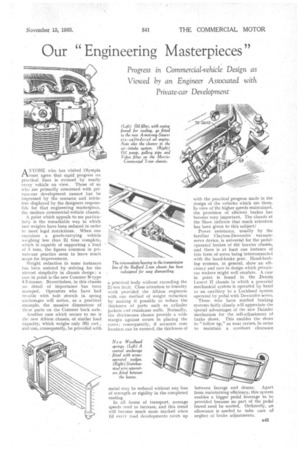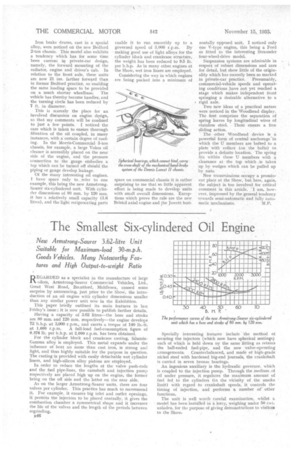Our "Engineering Masterpieces"
Page 71

Page 72

If you've noticed an error in this article please click here to report it so we can fix it.
Progress in Commercial-vehicle Design as Viewed by an Engineer Associated with Private-car Development
ANYONE who has visited Olympia must agree that rapid progress on practical lines is evinced by nearly every vehicle on view. Those of us who are primarily concerned with private-car development cannot but be impressed by the resource and initiative displayed by the designers responsible for that engineering masterpiece, the modern commercial-vehicle chassis.
A point which appeals to me particulady is the remarkable way in which tare weights have been reduced in order to meet legal restrictions. When one examines a goods-carrying vehicle weighing less than 21 tons complete, which is capable of supporting a load of 5 tons, the figures common in private-car practice seem to leave much scope for improvement.
Weight reduction in some instances has been assisted by striving for the utmost simplicity in chassis design ; a case in point is the new Commer N-type 4-5-tonner; Nevertheless, in this chassis no detail of importance -has been scamped: Operators who have had trouble with bolt stretch in spring anchorages will notice, as a practical example, the massive dimensions of these parts on the Commer back axle.
Another case which occurs to me is the new Albion chassis, of similar load capacity, which weighs only 36i cwt., and can, consequently, be provided with a practical body without exceeding the 2b-ton limit. Close attention to foundry work provided the Albion engineers with one method of weight reduction by making it possible to reduce the thickness of parts such as cylinder jackets and crankcase walls. Normally, the thicknesses chosen provide a wide margin against errors in placing the cores ; consequently, if accurate core location can be ensured, the thickness of metal may be reduced without any loss of strength or rigidity in the completed casting.
In all forms of transport, average speeds tend to increase, and this trend will become much more marked when (if ever) road developments catch up with the practical progress made in the design of the vehicles which use them. In view of the higher speeds maintained, the provision of efficient brakes has become very important. The chassis at the Show indicate that much attention has been given to this subject.'
Power assistance, usually by the familiar Clayton-Dewandre vacuumservo device, is universal for the pedaloperated brakes of thE heavier chassis, and there is at least one instance of this form of servo being interconnected with the band-brake gear. Hand-braking systems, in general, show an efficiency and care in design which privatecar makers might well emulate. A case in point is found in the -Dennis Lancet II chassis in which a powerful mechanical system•is operated by hand as an auxiliary to a Lockheed system operated by pedal with Dewaridre servo.
Those who have studied braking systems fairly closely will appreciate the special advantages of the new Daimler mechanism for the self-adjustment 'of brake shoes. This enables the shoes to "follow up," as wear occurs, in order to maintain a con:stant clearance
between facings and drums. Apart from maintaining efficiency, this system enables a bigger pedal leverage to be provided because no part of the pedal , travel need be wasted. Ordinarily, an allowance is needed to take care of neglect of brake adjustments. Iron brake drums, cast in a special alloy, were noticed on the new Bedford 2-ton chassis. This model also exhibits a tendency which has for some time been current in private-car design, namely, the forward mounting of the radiator, engine and driver's cab. In relation to the front axle, these units are now 21 ins, farther forward than in former Bedford practice, so enabling the same loading space to be provided on a much shorter wheelbase. The vehicle has thereby become handier, and the turning circle has been reduced by 7 ft. in diameter.
This is scarcely the place for an involved discussion on engine cicsign, so that my comments will be confined to just a few points. I noticed the care which is taken to ensure thorough filtration of the oil coupled, in many instances, with a certain degree of cooling. In the Morris-Commercial 3-ton chassis, for example, a large Yokes oil cleaner is accessibly placed on the near side of the engine, and the pressure connection to the gauge embodies a tap which can be turned off should the piping or gauge develop leakage.
Of the many interesting oil engines, I have space only to refer to one example, this being the new ArmstrongSaucer six-cylindered unit. With cylinder dimensions of 80 mm. by 1.20 ram, it has a relatively small capacity (3.6 litres), and the light reciprocating parts enable it to run smoothly up to a governed speed of 3,000 r.p.m. By making good use of light alloys for the cylinder block and crankcase structure, the weight has been reduced to 9.5 lb. per b.h.p. As in many other engines at the Show, wet iron liners are employed.
Considering the way in which engines are being packed into a minimum of space on commercial chassis it is rather surprising to me that so little apparent effort is being made to develop units with small overall dimensions. Exceptions which prove the rule are the new Bristol axial engine and he Jowett hori zontally opposed unit. I noticed only one V-type engine, this being a Ford as fitted to the interesting Straussler four-wheel-drive model.
Suspension systems are admirable in respect of robust dimensions and care for detail, but show little of the originality which has recently been so marked in private-car practice. Presumably, commercial-vehicle speeds and operating conditions have not yet reached a stage which makes independent front springing a desirable alternative to a 1 rigid axle.
Two new ideas of a practical nature were noticed in the Woodhead display. The first comprises the separation of spring leaves by longitudinal wires of stainless steel. These ensure a free sliding action.
The other Wooc'head device is a powerful form of central anchorage in which the U members are bolted to a plate with collars (on the bolts) to provide a definite location. The spring fits within these U members with a clearance at the top which is taken up by wedges which can be pulled up by nuts.
New transmissions occupy a prominent place at the Show, but here, again, the subject is too involved for critical comment in this article. I am, however, impressed by the general tendency towards semi-automatic and fully auto matic mechanisms. M.P.






















































































































